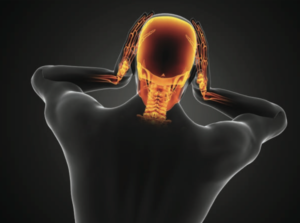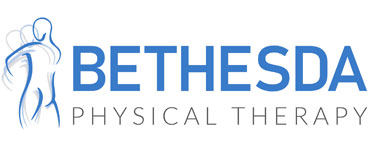Cervicogenic Headaches, A Pain in the Neck
Jun 29Download a PDF of our Cervicogenic Headaches Newsletter!
By Jessica Heath and Neal Goulet
 If you stick your neck out for someone, the saying suggests, then you’ve taken some risk.
If you stick your neck out for someone, the saying suggests, then you’ve taken some risk.
In this technology-driven age, we’re literally sticking our necks out at the risk of causing very real headache pain. An article in Men’s Journal used the term “the desk worker’s malady,” while a BBC story called it “text neck.”
“The problem is that we’re craning our heads forward over our screens,” according to the BBC, “and it’s creating intense pressure on the front and backs of our necks.”
That pressure can cause pain that manifests as a headache. This pain actually isn’t in the head but rather is “referred” from the neck.
The technical term for this is cervicogenic headache, or CGH, which by one estimate accounts for 15 to 20 percent of all headache disorders. The Journal of Manual and Manipulative Therapy noted:
“Although the prevalence of CGH is considerably lower than tension-type headache and migraine, patients with CGH have a substantial quality-of-life burden, comparable to patients with migraine and tension-type headache.”
The first part of “cervicogenic” refers to the cervical spine, comprising seven bones more commonly known as the neck; “genic” means that the headache is generated in this area, particularly the upper three bones. In other words, what feels like a dull, achy pain in the head really has its roots in the neck.
A “cervicogenic episode” can last one hour to one week. Pain typically is on one side of the head, often correlating with the side of the neck where there is increased tightness. Almost certainly, range of motion will be compromised.
Common causes of CGH can be chronic: poor posture, as noted above, or arthritis.
They also can be traumatic: the result of sudden, forceful movement of the skull and neck as with whiplash caused by a car accident, a fall, or an athletic collision.
Headaches that develop three or more months after a concussion, according to one study, generally are not caused by brain or head injury. This suggests a connection to the cervical spine.
This study also indicated that CGH affects four times more women than men. Neck positions and specific occupations, such as hairdressing, carpentry and truck/tractor driving, have been linked to CGH.
Diagnosis of CGH can be tricky because it can resemble other headaches and can trigger other headaches, such as a migraine.
Doctors may look for the source of the pain by attempting to use a nerve block. This involves an injection into the neck of an anesthetic that can help determine which nerve is causing the pain.
Those suffering from headaches try many remedies. Medication, massage and even botox injections have been used to address pain. Of course, medication can only mask the pain, not resolve its cause. One study found that botox was no better than a placebo at providing pain relief.
Most often, CGH results from the joints of the neck being stiff, sore and inflamed. The adjacent nerves become irritated and refer pain to the neck, shoulder and head, including the face and behind an eye.
What the abdominal muscles do to support the low back, the deep neck flexor muscles do for the neck. This group of muscles is on the front of the neck and helps with simple movements, including nodding and turning the head.
Over time, poor posture can weaken the deep neck flexors, allowing the head to move forward and changing the overall alignment of the spine. This could cause chronic neck pain if not corrected.
Physical therapy and an ongoing exercise regiment, according to the American Migraine Foundation, “often produce the best outcomes.”
Physical therapy as a treatment for headaches is a comprehensive approach. The therapist will conduct a detailed patient history, including stressors, work history and postures, and recreational activities that may contribute to the pain and other aggravating factors.
An initial assessment also will include palpation of the cervical muscles that are often painful and tight, range of motion assessment, cervical and thoracic mobility testing, postural muscle stabilization strength testing, and deep neck muscle strength and endurance testing.
Often, early treatment will begin with postural education and modalities to relieve pain and assist with compliance in maintaining good posture. Taping techniques can be used to alleviate pain and to assist with postural awareness.
Manual therapy (hands-on treatment) also will be used. Therapists may need to incorporate techniques to decrease the tone of muscles (over-developed because of compensation) in the cervical spine or improve the mobility in the cervical and thoracic spine.
As the treatment progresses, it is important for the therapist also to teach the patient good postural stability and strengthening exercises.
The combination of manual therapy, postural education and strengthening has been found to be effective in the treatment of cervicogenic headaches.
Click here for our video tutorial on workplace posture to avoid headaches!
RESEARCH ABSTRACT – MANAGING CERVICOGENIC HEADACHES WITH CONSERVATIVE TREATMENT
By Kyle Baiocchi
INTRODUCTION
Cervicogenic headaches are chronic or recurring in nature and have been found to arise from musculoskeletal dysfunction of the cervical spine (neck). The lifetime prevalence of headaches in adults may be as high as 20 to 30 percent.
Conservative treatment, such as physical therapy, often is recommended as a first line of headache management. Treatment may include manual therapy, exercise or a multimodal approach.
The purpose of this study was to assess the short- and long-term effectiveness of manual therapy and a low-load exercise program, used alone or in combination and compared with a control group that received no treatment.
METHODS
Participants ranging in age from 18 to 60 were included in the study if they experienced a headache that was unilateral (on one side) or unilateral dominant (worse on one side than the other) and associated with neck pain. These symptoms needed to be aggravated by neck postures or movements and present for at least one week over a period of two months to 10 years.
The subjects were randomly assigned to one of four groups: a control group that received no treatment; a group that received manual manipulative therapy; a group that received therapeutic exercise using low-load endurance exercises to the cervicoscapular region; and a group that received both manual therapy and therapeutic exercise.
RESULTS
All treatment groups demonstrated a significant reduction in headache frequency and intensity and neck pain immediately after treatment and at 12 months compared with the control group.
Seventy-two percent of participants achieved a reduction of 50 percent or more and 42 percent of participants reported 80 to 100 percent relief at the 12-month follow-up, which rendered the findings clinically relevant.
This study found that conservative treatment of combined manual therapy and a specific exercise program were effective in the management of cervicogenic headaches, with results being maintained in the long term.
DISCUSSION
Cervicogenic headaches are a common ailment suffered by adolescent and adult populations. Physical therapists have the potential to relieve symptoms of headaches and address underlying musculoskeletal impairments.
In six weeks of conservative therapy, the researchers achieved positive long-term outcomes and provided patients with self-management strategies of exercises and postural awareness to reduce the risk of recurrence.
CASE STUDY – PHYSICAL THERAPY FOR HEADACHES
By Misty Seidenburg
PATIENT HISTORY
A 49-year-old female was referred to physical therapy for complaints of chronic headaches. She was referred to therapy by her neurologist because of limited success with pharmacological treatment.
The patient, a stay-at-home mom, was responsible for all of the household chores and enjoyed playing computer games for two hours per day. Her headaches limited her ability to complete some of her household tasks such as laundry. She was unable to look at the computer or read for more than 30 minutes without a headache occurring that required migraine medication to relieve the pain.
At the time of evaluation, the patient complained of retro-orbital (behind the eye) headaches and suboccipital (base of the head) tenderness. She also noted a history of neck and thoracic stiffness that she attributed to stress. She rated her symptoms as 5-9 on a scale of 0 (no pain) to 10 (worst pain ever felt).
ASSESSMENT
Analysis of the patient’s posture revealed a forward head, rounded shoulders, and increased thoracic kyphosis (rounded mid-back). Cervical spine range of motion was significantly restricted with 30 degrees of flexion (normal 80-90); 10 degrees of extension (normal 70); 45 degrees of rotation bilateral (normal 90); side bending right 15 degrees and side bending left 5 degrees (normal 20-35), with cervical pain and stiffness in all directions.
Flexion and side bending also worsened the patient’s headache. The patient was tender to palpation along both upper trapezii and suboccipital musculature. Functional testing revealed limited overhead reach. Her head moved forward incorrectly when she reached overhead.
The physical therapist hypothesized that she suffered from cervicogenic headaches.
TREATMENT
Initial treatment consisted of postural correction; manual techniques including soft tissue massage to reduce muscle tone and tenderness along her upper trapezius and suboccipital muscles; and kinesiotaping to assist with pain relief by aiding postural control.
By the third visit, muscle tone and tenderness were reduced and cervical range of motion was minimally improved. The patient reported continued difficulty with sustained sitting postures but increased ease with doing laundry.
The addition of cervical retraction exercises to her program immediately improved cervical range of motion and overhead reach with decreased pain. To progress range of motion even further, manual treatment addressed upper thoracic mobility.
As the patient progressed, scapular stabilization, deep neck flexor strengthening, and functional reaching exercises were added to address her remaining impairments and self-reported activity restrictions.
SUMMARY
By the fourth week, the patient’s headaches were occurring seldom, requiring less medication to address her pain. She was able to complete most of her home activities but reported continued difficulty with sitting for more than one hour at a time.
The patient was progressed with manual treatment to address upper cervical mobility and was seen for two additional weeks to restore full functional cervical range of motion. At the time of discharge, she had achieved her range of motion goals and returned to all previous activities of daily living without symptoms or need for medication.
REFERENCES
“A randomized controlled trial of exercise and manipulative therapy for cervicogenic headache.” Jull, et al. Spine. September 2002 1;27(17):1835-43.
“Cervicogenic headache: the basics,” American Migraine Foundation website, accessed April 2016.
Hall, T., Briffa, K., and Hopper, D. “Clinical evaluation of cervicogenic headache: a clinical perspective.” Journal of Manual and Manipulative Therapy. 2008; 16(2): 73-80.
Page, P. “Cervicogenic headaches: an evidence-led approach to clinical management.” Int J Sports Phys Ther. September 2011; 6(3): 254-266.
Reavy David. “The real reason you have a headache.” Men’s Journal, July 27, 2015, accessed on mensjournal.com April 2016.
“The painful conditions you get from your smart phone.” BBC Newsbeat, June 19, 2015, accessed on bbc.co.uk April 2016.
